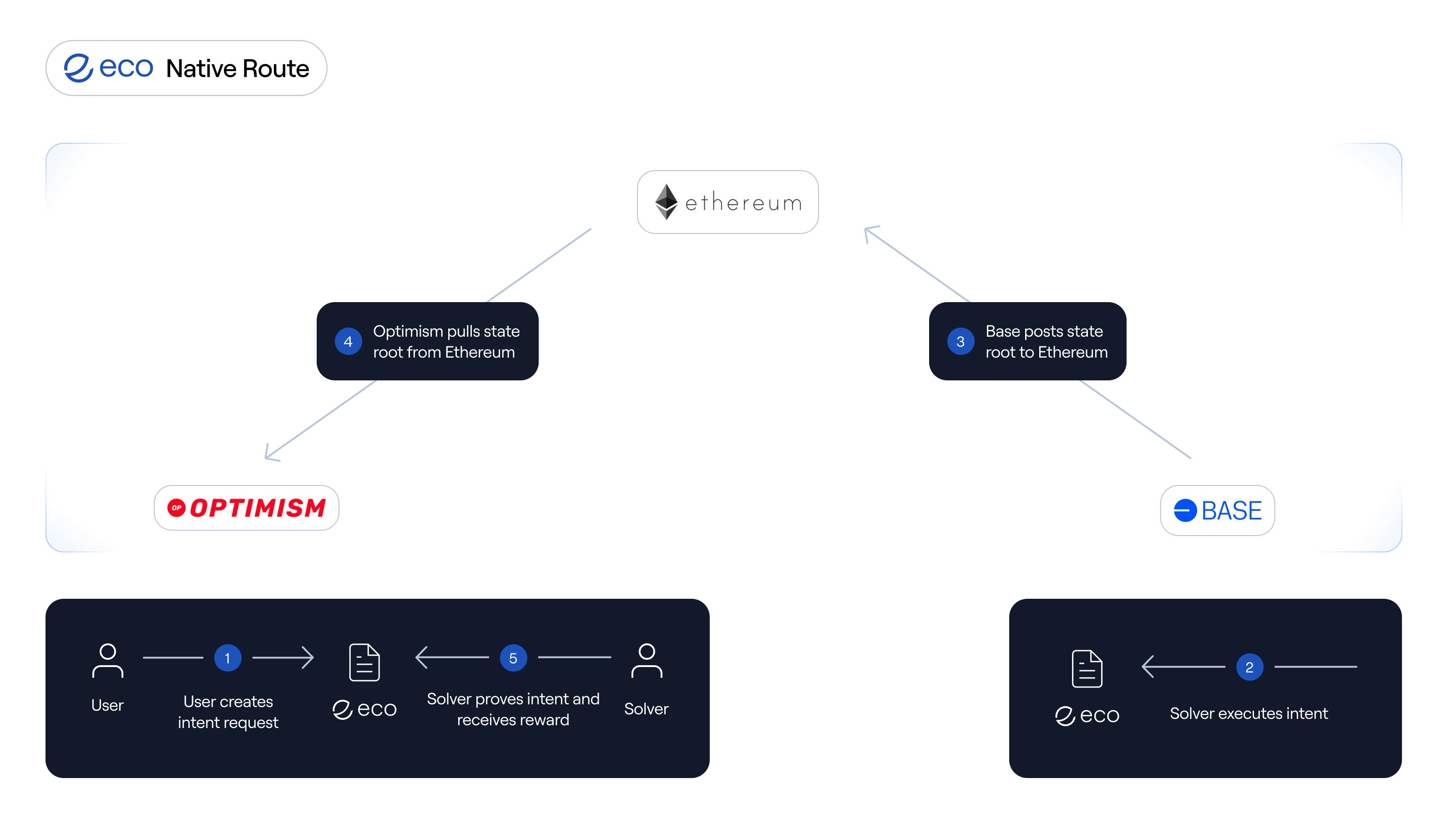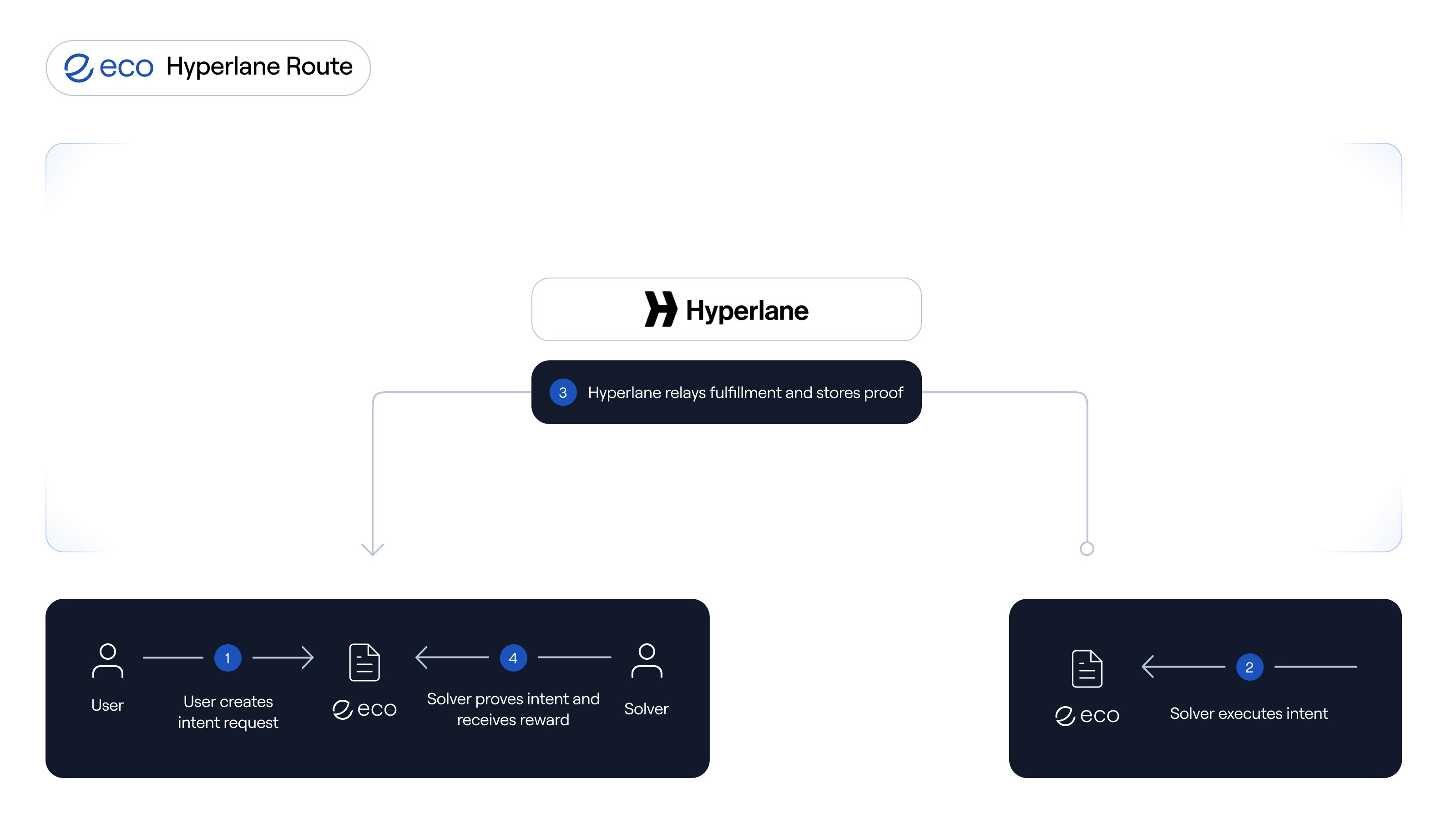Routes
Routes addresses the challenge of fragmented cross-chain liquidity by providing users the ability to request the fulfillment of actions on other chains, with a focus on stablecoin sends / swaps. For the Beta launch, Eco has released Routes on Arbitrum, Base, Celo, Ethereum, Ink, Optimism, Polygon, Unichain, Sonic, and World Chain. This version supports cross-chain transfers of stablecoins and like-kind assets between these chains.- Native Route: enables onchain apps with cross-chain transfers without any added trust assumptions. It implements a storage proof mechanism to verify cross-chain transfers using data already posted to Ethereum’s root by Ethereum Layer 2s.
- Hyperlane Route: enables onchain apps with fast cross-chain transfers secured by Hyperlane’s interoperability protocol. The Hyperlane Route optimizes stablecoin transfers for speed and low cost, using a messaging-based proof mechanism to validate cross-chain transfers.
Participants
Routes relies on an intent based architecture, where users specify the actions they want to happen on another chain. In this system, there are two actors, users and solvers.- Users are EOAs or smart contract wallets with a need to perform a payment or action on another chain. Typically, these users are using an application that has integrated the transfer system.
- Solvers are market participants who help users execute intents for a fee. For the Alpha release of the system, the architecture is optimized for applications that fill intents for their own users.
The following section discusses the technical details of the Eco Protocol. If you’re unfamiliar with concepts like Storage Proofs, please see the Storage Proofs section.
High-Level System Architecture
The Origin chain is the chain where the User requests the intent, and the Destination chain is the chain where the solver executes a transfer request. The system relies on 3 core contracts across these chains to manage cross-chain transfers:-
IntentSourceContract — lives on the Origin chain and is responsible for the management of intent origination, intent publication, and solver fulfillment. It deploysVaultcontracts to manage the custody of funds and collateral logic for each intent. -
InboxContract — lives on the Destination chain and is responsible for the management of intent fulfillment and prevention of double fills. -
ProverContract — lives on the Origin chain and is responsible for the management of intent fulfillment proof. Multiple types of prover contracts are currently supported in the Eco Protocol system. Different types of provers enable developers and app users to opt into speed or trust tradeoffs which best fit their needs.
Transfer Flow
Fulfilling a route request requires 4 basic steps. This example highlights an L2 to L2 transfer fulfillment:-
User Originates Request:
-
The user publishes an intent on the
IntentSourcecontract on the Origin chain. The intent specifies various details, including the destination chain, a set of functions that must be successfully called with corresponding calldata, the value to send per call, the prover responsible for validating intent fulfillment, and more. In most cases, these requests involve stablecoin contracts, where users request transfers to specific addresses. The user also specifies a set of reward tokens to incentivize the solver to fulfill the intent. -
If the user chose to publish and fund the intent at the time of request, the reward tokens are deposited into a
Vaultcontract address.IntentSourceutilizes theseVaultcontracts to manage the custody of funds and enforce collateral logic for each intent. -
Vaultcontracts are created using Create2, meaning that their addresses are deterministically computed. Consequently, when an intent request is successfully published, it is assigned a hash identifier that also serves as the address of the correspondingVaultcontract. This mechanism means that users are not required to publish the intent on the same chain where they plan to send the collateral. Instead, users can simply send the collateral to theVaultcontract address, and theVaultcan be deployed at claim time to facilitate either the distribution of rewards to the solver or the refund of funds to the user. This is a similar pattern to how smart contract addresses can be funded before the deployment of the smart wallet logic to the address.
-
The user publishes an intent on the
-
Solver Completes Request:
-
A solver sees the intent on the
IntentSourcecontract on the Origin chain. They call a function on theInboxcontract on the Destination Chain with the original data the user sent with the request. The contract calculates the hash based on the set of calls (which should match the hash on the Origin chain). -
The
Inboxcontract then executes the specific function calls. At the end of the calls, theInboxcontract makes sure that all the specified calls were successful, and if so, marks the intent as fulfilled. The intent is marked using a mapping that stores the address credited with the fulfillment, with the hash as the key. - Because the hash is unique, the contract prevents anyone else from submitting a fill for an intent with the same hash. This prevents two solvers accidentally filling the same intent!
-
A solver sees the intent on the
-
Solver Proves Fulfillment:
-
The Beta System supports two Routes: the Native Route and the Hyperlane Route. The Native Route uses the
Provercontract to prove intent fulfillment with storage proofs. The Hyperlane Route uses theHyperProvercontract to prove intent fulfillment. -
If the Native Path was selected during intent origination:
-
The solver then submits a proof on the Origin chain to the
Provercontract to claim the funds. The proof uses the L1Block oracle on the L2 to construct a series of Storage Proofs. These proofs derive the state root of the Destination chain and make it accessible in the execution context of the Origin chain. -
With the origin chain’s state root, the intent’s fulfillment can be proven via another storage proof. The proof proves that the intent was fulfilled on the Destination chain by proving the relevant storage slot in the
Inboxcontract using the Destination state root. - The Native Path requires the state root to be settled per the settlement criteria of the L2.
-
The solver then submits a proof on the Origin chain to the
-
If the Hyperlane Route was selected during intent origination:
-
During the fulfillment on the
IntentSource, the solver chooses whether they want an instant proof communication or to be added to a batch. -
If the instant fulfillment was selected, Hyperlane immediately sends a message that marks the intent as proven on the Origin chain in the
HyperProvercontract. -
If the batch fulfillment was selected, the intent is relayed in a batch by Hyperlane, which batches multiple intent fulfillments into a single message and marks them all as proven in the
HyperProvercontract.
-
During the fulfillment on the
-
The Beta System supports two Routes: the Native Route and the Hyperlane Route. The Native Route uses the
-
Solver Claims Reward
- After the intent is marked as fulfilled in the relevant Prover contract, the solver can claim funds by calling
IntentSource. If the intent was not fulfilled in time, the user can reclaim their funds after the end of the lockup period. Because intent source uses Create2 to derministically compute theVaultcontract address,IntentSourcewill deploy theVaultcontract to the predetermined address that holds the funds at the time of claim, send the reward tokens to the solver, and then self-destruct theVaultcontract. This ensures that theVaultcontract is only deployed when the solver is claiming funds and allows the user to initiate an intent with as little as a single token send on the source chain.
- After the intent is marked as fulfilled in the relevant Prover contract, the solver can claim funds by calling
Native & Hyperlane Routes Flows

Native Route Transfer Flow

Hyperlane Route Transfer Flow
Interoperability
The system is designed to be maximally flexible. All three of the main contracts in the system are designed to be able to be swapped out by users originating intents. This means that adding an alternative proof mechanism or alternative logic in the intent source contract is as simple as deploying different contracts and specifying them in contract calls.ERC-7683 Compatibility
The system supports the ERC-7683 standard via theEco7683OriginSettler.sol and the Eco7683DestinationSettler.sol contracts. These contracts are used to settle intents on the Origin and Destination chains respectively in the interfaces supported by ERC-7683.